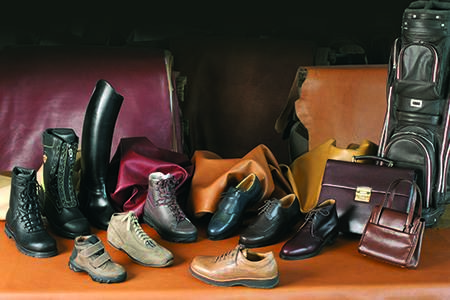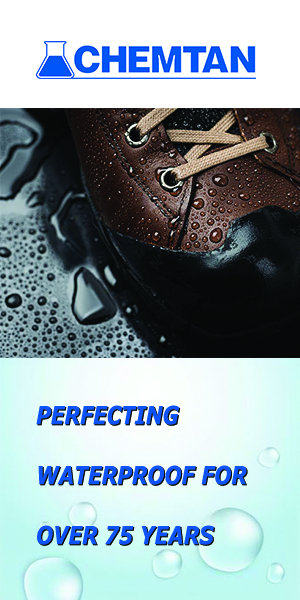Josef Heinen GmbH & Co KG, Wegberg, Germany

The Heinen tannery has been based in the town of Wegberg, in North Rhine-Westphalia in Germany, since 1891, producing quality leather for the high-end footwear market. The company places high importance on maintaining positive relationships with its employees, suppliers, and the local community, as well as with its customers.
For a company that feels like part of the fabric of the German leather industry, it’s interesting to note that around 95% of Josef Heinen GmbH’s output now leaves the country, a reflection, perhaps, of the changes that the German footwear industry, Heinen’s main market, has gone through in recent years.Some customer organisations are brands whose headquarters are still in Germany, but whose production set-up is “all over the place” now, according to Thomas Heinen, who is managing director of this family firm. However, with a strong focus on specialist outdoor footwear that requires expensive waterproof leather, the outsource manufacturers to whom the tannery dispatches orders are, in many cases, still in Europe; in fact, the company calculates that two-thirds of all its leather goes to eastern Europe.
Location
When the tannery was founded there was nothing around it except fields. The town has grown up around the tannery, but now some local people’s homes are joined onto the facility and were sometimes even able to feel vibrations from the drums when they were turning, before Heinen sourced quieter engines.
Today, the tannery is in the middle of the town and the managing director acknowledges that, for the Wegberg authorities, this is less than ideal. The facility functions 24 hours a day, which means people and vehicles moving in and out throughout the day and night. Some years ago, local people raised complaints about a foul smell and the city immediately blamed Heinen. A little investigation revealed a fruit-juice factory as the source, but not until after local press, and even a TV company, had linked the leather facility to the problem.
Thomas Heinen comments: “The biggest issues are noise, smell and people moving in and out around the clock. I’ve seen many tanneries and can honestly say that, for smell, ours is one of the best. Most departments keep their doors closed and we keep things as clean as possible. We know that if you leave old skins lying around, the place will stink.
“Our neighbours know that if there is a problem, they can come through the door any time, and they know whom to talk to. We take them seriously, and we take their complaints seriously because we know that if we ignore any problem, it will get bigger and become something we can’t manage any more.”
With the possible exception of Scandinavia, Germany has been more deeply influenced by green politics than almost any other part of the world. Green politicians have helped form national and regional governments on many occasions in the last 15 years, including, as recently as 2005, in Heinen’s home region, North Rhine-Westphalia.
Thomas Heinen explains that, 20 or 30 years ago, managing this was more difficult for tanneries than it is today. Leather producers in Germany found themselves facing compliance and legal issues that few of their competitors in other countries had even thought about at that time. Substantial investment in waste and water management took place and—something that seems curious now—they had to be careful not to give their customers wind of what was going on in case they, the customers, worried about extra cost.
Today, most competitors face similar compliance questions, although the Heinen managing director believes the authorities in many parts of the world may be slightly better at talking about controlling pollution than at carrying out audits to make sure companies comply (Germany is avid about audits).
So, approaching the second decade of the twenty-first century, he is convinced that the only path to survival for a company such as his is to offer quality products. That means more than bringing beautiful leather to market; how it’s made and the impact its production has on the planet are important questions too. He says: “I think it’s now become an advantage for us to be at a stage that a lot of companies in the leather industry have not achieved yet. Leather, paper and textiles are potentially polluting industries, so to be able to offer cleaner, greener leather is an advantage, provided our customers are willing to market that to the end consumer.”
Terracare initiative
Terracare is a new concept that Heinen has developed to help footwear brands respond to consumers’ desire for more environmentally friendly shoes. The tannery has developed a new label and hang-tag and is at an advanced stage in discussions with a number of important customers with regard to using Terracare as part of their marketing. Heinen’s main motivation in launching Terracare is that it wishes:
• customers to understand how its leathers are produced.
• to give customers the tools to make a solid leather purchasing decision, for or against the environment
• customers to know that leather quality consists of many factors
• to leave the smallest possible footprint behind, together with business partners who share its views and passions.
Under the label Terracare, Heinen brings together four major elements that have been identified for producing leathers in the most ecologically and socially responsible way.
It is said that water will be the oil of the twenty-first Century. Of the total world reserves, only 0.33% is suitable as clean water suitable for food production, human and animal consumption. Even so, this resource is not evenly distributed and should be used with respect.
Accordingly, its use has been optimised within the manufacturing process at Heinen. Since 2003 water consumed has been reduced from an already efficient level to 72% of this value by 2007. Today, only 90 litres of water is consumed for every square-metre of finished leather produced.
Moreover, at the end of the production process the waste water is treated to German and European standards for discharge to sewer. All legal requirements are met as controlled by independent authorities.
Energy is consumed in the manufacture of all goods, and the generation of this energy causes a release of carbon dioxide. This damages the protective shield of our atmosphere against sunlight, and is considered a cause of global warming and all related consequences.
With this understanding, the Heinen tannery has sought to optimise energy use. Hides are delivered to the tannery in special lightweight containers owned by the company to minimise fuel consumption in transport. Machinery has been selected with careful consideration to its power consumption. Lighting has been optimised and heat from machinery used for drying purposes as detailed within other parts of this company profile. Moreover, the energy created from bio-gas production reduces the total energy balance. The energy consumed directly since 2003 has been reduced to 85.6% by 2007. This is then offset by the energy produced by bio-gas, which now stands at 14.7% of the total energy needs of the tannery.
A considerable amount of chemicals and materials are used in leather manufacture, and respect for the environment has been addressed by the:
• purchase of approved and compliant chemicals from reputable and trustworthy companies.
• selection of chemicals that biodegrade wherever possible.
• use of the most appropriate technology.
• transport on modern trucks in safe containers.
• loading and unloading of all chemicals over drip pans.
• storage of chemicals in a specially equipped warehouse.
• storage of liquid chemicals in secure tanks.
• dosage of liquid chemicals through automated systems.
• minimised chemical use through modern equipment.
• experienced and well trained technicians.
Care is taken in the choice of raw hides. This involves the use of government veterinarians to ensure humane conditions and the safety standards concerning infections. It also involves the best use of by-products from manufacture as new raw materials as detailed within other parts of this report, and the minimisation of waste for controlled disposal.
The final leathers are tested including for compliance to German and EU laws and regulations, and requirements as set by customers to meet the standards of private labels. In addition, the leathers meet the internal standards set for the Terracare label, as performed and approved by independent certified institutions.
Responsibilities are perceived in global terms, and this has been expressed in terms of a carbon dioxide equivalent. This requires measurement of the energy consumption for each stage of movement of goods, operation, process, treatment of effluent and, for example, the energy required for:
• the transport of raw hides, contract tanned hides, and chemicals to the tannery.
• all chemical processing.
• all mechanical operations.
• the transport and movement of goods within the tannery.
• space heating, drying and lighting.
• the energy consumed for the full treatment of effluent.
These values as kilowatt hours are then offset by the quantity of energy generated by bio-gas production. The energy use is then converted into a value as kilos of carbon dioxide released by combustion to produce this energy. In turn these values can be applied to each type of leather across the whole thickness range of the finished leathers. The average values are given as 2.81 kilos of carbon dioxide for each square-metre of leather produced.
In launching Terracare, Heinen is making no claims about eco-leather, but it is attempting to offer the market leather that is cleaner and greener. In the build-up to this idea, which it launched a year ago, the tannery set about measuring what impact every step of the production process, including every light bulb burning on every part of the site, contributes to the carbon emissions attributable to each square-metre of finished leather.
Using information in the public domain and accessible online, as well as the information that the Leather Working Group has published about the tanneries its big end-user organisations have put forward for accreditation, and information he has received from colleagues he knows well in the German tanning sector, Thomas Heinen feels he has “concrete numbers” to validate Terracare. He explains: “Our products remain the same. We’ve been consuming as little water and as little energy as possible to produce our leather for a long time. But I thought it was worth cataloguing carbon emissions for each of our products, even though I knew, of course, that thicker leather would show a higher figure because less leather fits into the drum each time, the running time is longer and the effluent requires more treatment.”
The idea was prompted by a concept launched at a new tannery in Vietnam, which is claimed to reduce carbon emissions by 35% compared to traditional leather producing facilities. An environmental consultant invloved on that project has worked with Heinen on the Terracare initiative too.
Relationships with chemical companies
Mr Heinen’s feeling about the providers of leather chemicals he deals with is that they might have made too much money for too long, which has been good news for them, but has led them to develop an inaccurate view of how the real world works. He remembers a time when the main provider his company worked with would simply get in touch to say that prices were going up and that there would be a new contract to sign. Then competition in Europe increased and, suddenly, the price of dyestuffs went from around ?30 per kilo to 25 and then 15, suggesting margins were over-genious. That time has gone. Not withstanding worldwide competition and availability Mr Heinen only buys from providers based in northern Europe.
Price-wise, chemical providers may be keen to squeeze an extra margin but, in his opinion, the downturn in business for tanners who focus on the automotive industry has affected the chemical sector too.
“In general, the chemical companies have one technician for the wet end, say, and we deal with that technician,” he explains. “I prefer to talk to the technical person. For me, that one person is the chemical company.”
People management
Thomas Heinen believes firmly that the people who work in the tannery have the power to change his company. He says: “We don’t have a hierarchy here because I like people to tell me straight what they think; they all call me by my first name, which is unusual here in Germany. They know their jobs and they know their machines and the smart thing for me to do is to listen to them.”
It’s a multi-cultural group, with perhaps 20% of the workforce of 100 having Turkish origins. The managing director says he greatly values their flexibility and the support they offer when he needs people to work overtime at short notice or to sacrifice part of their weekend.
The characters working at the facility include Hubert Kamps, whose domain is the beamhouse. A senior member of the workforce, he chose strenuous manual labour on the advice of a doctor, having gained a lot of weight while in his twenties. He took up serious exercise and became a top triathlete. He also ran marathons, achieving a high finish in New York one year.
Another senior member of the team is Ralf Düchting, who works on wet blue sorting, putting orders together. He sorts according to the colour and thickness the finished leather must have to fulfil an order. He knows the finished products intimately and knows what Heinen customers are looking for. He’s been doing the job for 28 years and can assess each hide in a matter of seconds.
Originally from Spain, Manuel Villanueva has been living in the town of Wegberg and working at the local tannery for 20 years. His specialism is wet blue shaving, making sure the hides are of even thickness. He is slight of build, but lifts each hide as though he were taking a bag of sugar from a supermarket shelf. “The hides are heavy,” he says, “but when you’ve done the job for as long as I have, you take it in your stride.”
The company’s managing director repeats the point that having good people in place is the difference between success and failure for a business like his. “If you have the wrong guy doing wet blue sorting or on wet blue shaving, you’d be finished in five or six months.”






























